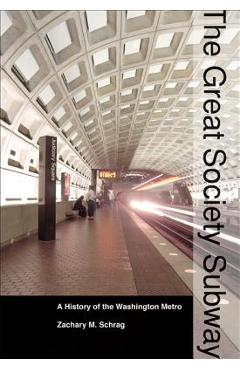The Great Society Subway: A History of the Washington Metro - Zachary M. Schrag

Detalii The Great Society Subway: A
libris.ro
267.84 Lei
297.6 Lei
History
Zachary M. Schrag
The Great Society Subway: A - Disponibil la libris.ro
Pe YEO găsești The Great Society Subway: A de la Zachary M. Schrag, în categoria History.
Indiferent de nevoile tale, The Great Society Subway: A History of the Washington Metro - Zachary M. Schrag din categoria History îți poate aduce un echilibru perfect între calitate și preț, cu avantaje practice și moderne.
Preț: 267.84 Lei
Caracteristicile produsului The Great Society Subway: A
Comandă The Great Society Subway: A Online, Simplu și Rapid
Prin intermediul platformei YEO, poți comanda The Great Society Subway: A de la libris.ro rapid și în siguranță. Bucură-te de o experiență de cumpărături online optimizată și descoperă cele mai bune oferte actualizate constant.
Descriere magazin:
As Metro stretches to Tysons Corner and beyond, this paperback edition features a new preface from the author. Drivers in the nation\'s capital face a host of hazards: high-speed traffic circles, presidential motorcades, jaywalking tourists, and bewildering signs that send unsuspecting motorists from the Lincoln Memorial into suburban Virginia in less than two minutes. And parking? Don\'t bet on it unless you\'re in the fast lane of the Capital Beltway during rush hour. Little wonder, then, that so many residents and visitors rely on the Washington Metro, the 106-mile rapid transit system that serves the District of Columbia and its inner suburbs. In the first comprehensive history of the Metro, Zachary M. Schrag tells the story of the Great Society Subway from its earliest rumblings to the present day, from Arlington to College Park, Eisenhower to Marion Barry. Unlike the pre-World War II rail systems of New York, Chicago, and Philadelphia, the Metro was built at a time when most American families already owned cars, and when most American cities had dedicated themselves to freeways, not subways. Why did the nation\'s capital take a different path? What were the consequences of that decision? Using extensive archival research as well as oral history, Schrag argues that the Metro can be understood only in the political context from which it was born: the Great Society liberalism of the Kennedy, Johnson, and Nixon administrations. The Metro emerged from a period when Americans believed in public investments suited to the grandeur and dignity of the world\'s richest nation. The Metro was built not merely to move commuters, but in the words of Lyndon Johnson, to create a place where the city of man serves not only the needs of the body and the demands of commerce but the desire for beauty and the hunger for community. Schrag scrutinizes the project from its earliest days, including general planning, routes, station architecture, funding decisions, land-use impacts, and the behavior of Metro riders. The story of the Great Society Subway sheds light on the development of metropolitan Washington, postwar urban policy, and the promises and limits of rail transit in American cities.

Produse asemănătoare

The First Great Charity of This Town. Belfast Charitable Society and its Role in the Developing City, Hardback/***
![]() elefant.ro
elefant.ro
Actualizat in 02/07/2025
200.99 Lei

Hollywood and the Great Depression. American Film, Politics and Society in the 1930s, Paperback/***
![]() elefant.ro
elefant.ro
Actualizat in 02/07/2025
194.99 Lei

S.O.S.: Society of Substitutes #1: The Great Escape, Paperback/Alan Katz
![]() elefant.ro
elefant.ro
Actualizat in 02/07/2025
29.99 Lei

The Great Society Subway: A History of the Washington Metro - Zachary M. Schrag
![]() libris.ro
libris.ro
Actualizat in 05/06/2025
267.84 Lei

The Seventies: The Great Shift in American Culture, Society, and Politics - Bruce Schulman
![]() libris.ro
libris.ro
Actualizat in 05/06/2025
111.55 Lei
Produse marca Zachary M. Schrag

The Great Society Subway: A History of the Washington Metro - Zachary M. Schrag
![]() libris.ro
libris.ro
Actualizat in 05/06/2025
267.84 Lei
